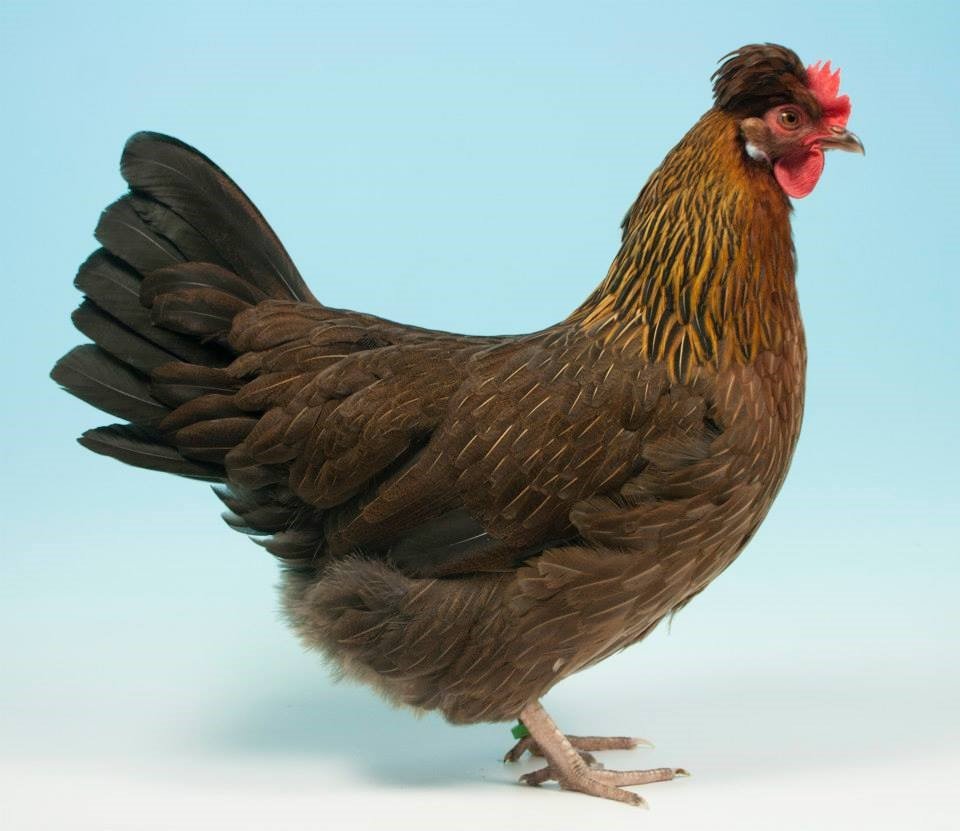The Altsteirer originated in the Steirermark region of Austria near Graz in 1860s, and is thought to have been initially developed for egg production, using the bloodlines of local farmyard chickens and imported Asiatic fowl. The resulting birds were given the name of ‘Altsteirer’ which roughly translates as ‘old Styrian fowl’. A breed club was formed in Graz and a breed standard followed in 1894. In Germany, the bantam version or ‘Zwerg-Altsteirer’ was developed and accepted as a standard breed in 1961.
The breed is of medium weight and height, of strong build, and with a striking crest. The Altsteirer is an agile, strong country fowl, quick maturing, with fair meat and egg production. Bantams are particularly lively and confident, not flighty. They are not very large birds, but are hardy and robust having been developed in the climatic conditions of an Alpine region. They have a naturally inquisitive nature and much prefer to free range. Although several colours can be found within Europe including white, cuckoo, mottled, and silver duckwing, only the original ‘Wild Brown’ or Partridge colour has ever been seen in the UK.
General Characteristics: male
Type: Body long, full and deep; breast broad, full and rounded, carriage horizontal. It has a body proportion ratio of 8:5:3 where ‘8’ is the body length, ‘5’ is the body depth and ‘3’ is the body width, giving the appearance of a substantial brick-shaped bird. Back broad and very slightly sloping towards a full saddle. Tail full, widely fanned and quite long with pronounced well arched main and abundant secondary sickles, carried around 45° angle to the back, and no cushion development. Wings medium length carried closely, with broad wing feathers.
Head: Fairly small size. Beak slightly short. Eyes round, full and prominent. Comb single, straight, upright and of medium size with a tendency to be flyaway, finely but not too deeply serrated with ideally six to eight short spikes. A slight wave in comb is allowed. Behind the comb is a small but smart tassel of feathers. Earlobes are of small size and oblong shaped. Wattles are medium length and rounded. Face, comb, wattles and earlobes are very smooth and fine in texture.
Neck: Medium length, straight, with a richly feathered neck hackle.
Legs and feet: Thighs fairly short but powerful and well fleshed, shanks medium to short in length, clean shanks. Toes four, finely boned, straight and well spread.
Plumage: Abundant but close fitting with rich glossy feathers.
Female
The general characteristics are similar to those of the male, allowing for the natural sexual differences. But the hen has a small `Wickel' or `S' shaped comb, with the front part falling to one side and back to the other side (irregular). The crest at the back of the comb should be half-rounded and should not obscure the vision. The wattles are smaller than those of the male and the body appears almost completely horizontal, and of less heavy set than the male.
BANTAM
Bantam Altsteirer should follow the exact standard of the large fowl.
The breed is of medium weight and height, of strong build, and with a striking crest. The Altsteirer is an agile, strong country fowl, quick maturing, with fair meat and egg production. Bantams are particularly lively and confident, not flighty. They are not very large birds, but are hardy and robust having been developed in the climatic conditions of an Alpine region. They have a naturally inquisitive nature and much prefer to free range. Although several colours can be found within Europe including white, cuckoo, mottled, and silver duckwing, only the original ‘Wild Brown’ or Partridge colour has ever been seen in the UK.
General Characteristics: male
Type: Body long, full and deep; breast broad, full and rounded, carriage horizontal. It has a body proportion ratio of 8:5:3 where ‘8’ is the body length, ‘5’ is the body depth and ‘3’ is the body width, giving the appearance of a substantial brick-shaped bird. Back broad and very slightly sloping towards a full saddle. Tail full, widely fanned and quite long with pronounced well arched main and abundant secondary sickles, carried around 45° angle to the back, and no cushion development. Wings medium length carried closely, with broad wing feathers.
Head: Fairly small size. Beak slightly short. Eyes round, full and prominent. Comb single, straight, upright and of medium size with a tendency to be flyaway, finely but not too deeply serrated with ideally six to eight short spikes. A slight wave in comb is allowed. Behind the comb is a small but smart tassel of feathers. Earlobes are of small size and oblong shaped. Wattles are medium length and rounded. Face, comb, wattles and earlobes are very smooth and fine in texture.
Neck: Medium length, straight, with a richly feathered neck hackle.
Legs and feet: Thighs fairly short but powerful and well fleshed, shanks medium to short in length, clean shanks. Toes four, finely boned, straight and well spread.
Plumage: Abundant but close fitting with rich glossy feathers.
Female
The general characteristics are similar to those of the male, allowing for the natural sexual differences. But the hen has a small `Wickel' or `S' shaped comb, with the front part falling to one side and back to the other side (irregular). The crest at the back of the comb should be half-rounded and should not obscure the vision. The wattles are smaller than those of the male and the body appears almost completely horizontal, and of less heavy set than the male.
BANTAM
Bantam Altsteirer should follow the exact standard of the large fowl.
Please contact the breed registrar for more information - [email protected]


